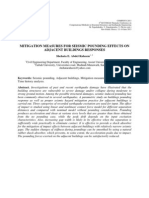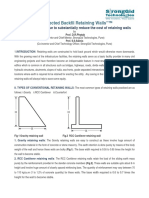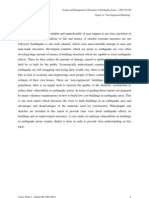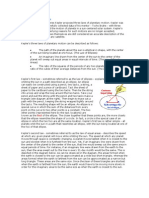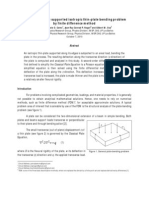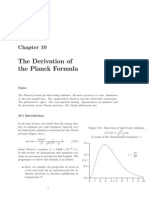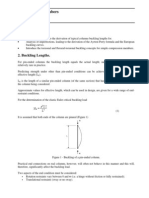Literature Review of Base Isolation
Literature Review of Base Isolation
Uploaded by
Sajol SarkerCopyright:
Available Formats
Literature Review of Base Isolation
Literature Review of Base Isolation
Uploaded by
Sajol SarkerOriginal Description:
Original Title
Copyright
Available Formats
Share this document
Did you find this document useful?
Is this content inappropriate?
Copyright:
Available Formats
Literature Review of Base Isolation
Literature Review of Base Isolation
Uploaded by
Sajol SarkerCopyright:
Available Formats
CHAPTER 2 LITARATURE REVIEW 2.1 INTRODUCTION: A common perception on how to resist an earthquake force is by strengthening the structure.
The traditional engineering design strategy based on increasing the design capacity and stiffness to accommodate foreseeable lateral forces may not be the most efficient solution. The problem with the latter is that all seismic forces from the foundation will be absorbed by the superstructure. The base isolation technique is exactly the opposite of traditional engineering design strategy. Base isolation is a system that protects a building from the damaging erects of a seismic movement. If the structure separates form the ground during an earthquake, the ground is moving but the structure is still dormant. However, this scenario is not realistic. The current technology that is active and expanding is the introduction of a low lateral stiffness support that isolates the structure from the ground movement. This technology was introduced as early as the 1900s; however, not until the 1970s did it evolve into the practical strategy for seismic-resistant design.
2.2 BACKGROUND OF BASE ISOLATION: In this age of technological evolution, the field of seismic engineering has a reputation for creative thinking and advanced technology beyond conventional solutions. Seismic isolation is a fitting technology. In this section we will look at the history of base isolation how and why it works. The Earthquake Engineering Research Centre (EERC), now known as the Pacific Engineering Research Centre (PEER), of the University of California at Berkeley, was the first institution in the United States to conduct a study on the feasibility of using raw rubber bearings as base isolators to defend buildings from earthquakes. This was in 1976. The study undertaken was a combined effort between the EERC and the Malaysian Rubber Producers Research Association (MRPRA) from the United Kingdom. In the beginning, this study program was fully financed by the MRPRA and later on by the National Science Foundation and the Electric Power Research Institute. The concept of base isolation had been around for quite a while. Most professionals in the field of structural engineering believed that the idea of using rollers or sliders for base isolation was totally nonviable and not suitable. The study program started with a simple three story, twenty ton model. Handmade bearings, produced from very low cost rubber, were used at the commencement of the research. Shaking table trials carried on the model established that the application of isolation bearings was able to decrease the acceleration by a factor up to 10 in equivalence with conservative designs. The research program proved that the model reacted as a stiff body and all the twist took place only in the isolation system. This early research directed the need towards a
certain degree of damping in the projected system; due to the tiny extent of the model, the use of more practical combinations of rubber was ruled out. In 1978, a five-storied, three bay, forty ton model was used to study base isolation when commercially produced bearings with increased damping were used. This study, conducted with the help of five tests, proved that the isolation attained through rubber bearings had the capacity of considerably decreasing the increase in speed felt by the structure itself. The very same study also demonstrated that the utilization of extra elements like lead plugs in the bearings or energy absorbing devices made of steel in the isolation system to enhance the quantity of damping lessened the capability of the isolation system in decreasing the acceleration felt by the internal equipment. This directed the study in finding a wellorganized way to add in the damping inside the rubber bearing, and not as a disconnected element supplemented to the isolation system. Actually the rubber bearings are effective isolators because they are comparatively effortless to manufacture, can survive the test of time, are fixed, and are outstandingly resistant to ecological degradation. Rubber bearings manufactured by binding sheets of vulcanized rubber to thin reinforcing plates made of steel tend to be supple horizontally, while being very stiff in the vertical direction. Thus during seismic action, the sheet of bearings secluded the structure from the horizontal components of ground motion, and the vertical factors transferred to the building remain intact. Vertical acceleration does not affect most structures, and the bearings also have the capacity to isolate the building from undesirable high-rate vertical vibration formed by sources such as traffic and underground railways.
2.3 PURPOSE OF BASE ISOLATION: A high proportion of the world is subjected to earthquakes and society expects that structural engineers will design our buildings so that they can survive the effects of these earthquakes. As for all the load cases we encounter in the design process, such as gravity and wind, we work to meet a single basic equation: CAPACITY > DEMAND We know that earthquakes happen and are uncontrollable. So, in that sense, we have to accept the demand and make sure that the capacity exceeds it. The earthquake causes inertia forces proportional to the product of the building mass and the earthquake ground accelerations. As the ground accelerations increases, the strength of the building, the capacity, must be increased to avoid structural damage. It is not practical to continue to increase the strength of the building indefinitely. In high seismic zones the accelerations causing forces in the building may exceed one or even two times the acceleration due to gravity, g. It is easy to visualize the strength needed for this level of load strength to resist 1g means than the building could resist gravity applied sideways, which means that the building could be tipped on its side and held horizontal without damage.
Figure 2-1: Design for 1g Earthquake Loads. Designing for this level of strength is not easy, nor cheap. So, most codes allow engineers to use ductility to achieve the capacity. Ductility is a concept of allowing the structural elements to deform beyond their elastic limit in a controlled manner. Beyond this limit, the structural elements soften and the displacements increase with only a small increase in force. The elastic limit is the load point up to which the effects of loads are non-permanent; that is, when the load is removed the material returns to its initial condition. Once this elastic limit is exceeded the load is removed the material returns to its initial condition. Once this elastic limit is exceeded changes occur. These changes are permanent and nor-reversible when the load is removed. These changes may be dramatic when concrete exceeds its elastic limit in tension a crack forms or subtle, such as when the flange of a steel girder yields. For most structural materials, ductility equals structural damage, in that the effect of both is the same in terms of the definition of damage as that which impairs the usefulness of the object. Ductility will generally cause visible damage. The capacity of a structure to continue to resist loads will be impaired. A design philosophy focused on capacity leads to a choice of two evils: 1. Continue to increase the elastic strength. This is expensive and for buildings leads to higher floor accelerations. Mitigation of structural damage by further strengthening may cause more damage to the contents than would occur in a building with less strength. 2. Limit the elastic strength and detail for ductility. This approach accepts damage to structural components, which may not be repairable. Figure 2-2: Ductility.
Base isolation takes the opposite approach, it attempts to reduce the demand rather than increase the capacity. We cannot control the earthquake itself but we can modify the demand it makes on the structure by preventing the motions being transmitted from the foundation into the structure above. So, the primary reason to use isolation is to mitigate earthquake effects. Naturally, there is a cost associated with isolation and so it only makes sense to use it when the benefits exceed this cost. And, of course, the cost benefit ratio must be more attractive than that available from alternative measures of providing earthquake resistance.
2.4 PRINCIPLE OF BASE ISOLATION: The basic objective with seismic isolation is to introduce horizontally flexible but vertically stiff components (base isolators) at the base of a building to substantially uncouple the superstructure from high-frequency earthquake shaking. The basic concept of base isolation system is lengthening the natural period of the fixed base building. The benefits of adding a horizontally compliant system at the foundation level of a building can be seen in Figure 2.3, (a) using an acceleration response spectrum. Increasing the period of the structure reduces the spectral acceleration for typical earthquake shaking. Displacements in isolated structures are often large and efforts are made to add energy dissipation or damping in the isolation system to reduce displacements as shown in Figure 2.3, (b) using a displacement response spectrum. The addition of damping to the isolation systems serves to reduce displacements in the seismic isolators, which can translate into smaller isolators.
a) Acceleration Curve
b) Displacement Curve Figure 2-3: Period Shift Effect.
2.5 BASIC ELEMENTS OF BASE ISOLATION: A flexible mounting so that the period of vibration of the building is lengthened sufficiently to reduce the force response. A damper of energy dissipater so that the relative deflections across the flexible mounting can be limited to a practical design level. A means of providing rigidity under low (service) load levels such as wind and braking force.
2.6 TYPES OF BASE ISOLATERS:
Figure 2-4: Schematic Diagram showing various types of Isolators used throughout the world.
The most common use of base isolator in building is given below: 1. Laminated Rubber (Elastomeric) Bearing. 2. High Damping Rubber (HDR) Bearing. 3. Lead Rubber Bearing (LRB). 4. Flat Sliding bearings. 5. Friction Pendulum (FPS) System Bearing.
2.6.1 LAMINATED RUBBER (ELASTOMERIC) BEARING: Elastomeric bearings have been used widely in bridges as bearing pads between the girder and the supporting structure for many years. Elastomeric bearings have multiple layers of steel shims and rubber laminated together under high pressure and heat in a mold. Steel shims prevent lateral bulging of the rubber when axially loaded. They do not resist shear forces and do not prevent the horizontal deformation of the layered rubbers. Therefore, steel shims increase the vertical stiffness of isolators but do not increase the lateral stiffness of elastomeric bearings.
Figure 2-5: Elastomeric Bearings Under Shear Test. Figure 2.5 shows elastomeric bearings subjected to dynamic shear test. The uneven surface of the elastomeric bearings shown is due to its steel shims. Generally, elastomeric bearings have low critical damping resistance, approximately 2% to 3% of critical viscous damping; and have minimal resistance under service loads. Therefore elastomeric bearings need to be improved. The result is a high damping elastomeric bearings and the lead rubber bearings. 2.6.2 HIGH DAMPING RUBBER (HDR) BEARING: As an alternative to elastomeric bearings, high damping rubber bearings provide critical damping from 10% to 20% at 100% shear strains. The construction methodology is the same with elastomeric bearings; however, the damping is increased by adding carbon block and other fillers. In addition, it has an adequate resistance to service loads. The damping characteristic is in between hysteretic and viscous. The energy dissipation is linear and quadratic for hysteretic and viscous, respectively. The energy absorption capacity help reduced the earthquake energy transmitted to the superstructure. The load capacity of HDRB can be computed using the same method as elastomeric bearings. The damping value can be computed using the equivalent damping ratios for specific elastomeric compounds.
2.6.3 LEAD RUBBER BEARINGS (LRBs): Lead rubber bearings are elastomeric bearings that contain one or more lead plugs inserted into their preformed holes. The lead provides significant stiffness under service loads and low lateral loads as compare to elastomeric bearings. Figure 2.6 shows the alternating sheet of steel shims and rubbers circumscribing a lead core. In addition, the lead serves as energy dissipation mechanism under severe lateral loads.
Figure 2-6: Lead Rubber Bearing with Layers of Rubber and Steel and Lead Core. During high lateral loads, the lead yields and the lateral stiffness of the LRB is significantly reduced. This increases the duration of the period of the structure and thereby serves the purpose of base isolation system. The bearing is cycled into a hysteretic damping as it absorbs the energy. LRB has a range of damping from 15% to 30% which is a function of displacement. The LRB are the most common base isolator used for isolating midrise buildings. It is usually designed and optimized according to a specific performance based target design. It combines the stiffness needed for service loads and low lateral loads while providing the flexibility and damping needed for high lateral loads. A wide array of damping and stiffness is possible through the use of LRB. As for the case of HDRB design, the formulas of elastomeric bearings are suitable for the design of LRB. 2.6.4 FLAT SLIDING BEARINGS: Flat sliding bearings consist of PTFE (Teflon) disc that slides on a stainless steel plate. They provide a perfectly plastic hysteresis shape, and adequate stiffness under service loads with high damping properties. In addition, the coefficient of friction is a function of both pressure and velocity of sliding. It provides the resistance under service loads. However, it must be combined with other bearings (i.e. HDRBs, LRBs) because it has no capability to return to its initial position.
Figure 2.7 shows an assembly of flat sliding bearing, which has the stainless steel plate supporting the circular disc. There is no other part in the assembly that shows that it has the capability to return to its initial position. A modified version of flat sliding bearing that has self-restoring force is the friction pendulum bearings.
Figure 2-7: Assembly of Flat Sliding Bearing.
2.6.5 FRICTION PENDULUM BEARINGS: The friction pendulum bearings have the same properties as the flat sliding bearings. However, the sliding surface is concave in shape rather than flat as shown in Figure 2.8. The hemisphere at the center of the concave surface is the pendulum slider. The spherical concave surface provides a restoring force to the pendulum slider to return to its initial position.
Figure 2-8: Friction Pendulum Bearing Assembly.
Varying the radius of the concave surface varies the stiffness of the friction pendulum bearings. In addition, once the coefficient of friction is overcome the lateral movement of the mass is accompanied by a vertical movement of the mass because of the curved shape of the slider. As for the case of LRB, the friction pendulum bearings have a wide array of damping and stiffness design capabilities.
2.7 SELECTION OF BASE ISOLATION TYPE: No one type of base isolation device is perfect. If it were, all projects would use the same type of device. Of the types available, following is a summary of their characteristics and advantages and disadvantages. Each project will have specific objectives and constraints and so it will need to select devices that best fit the specific criteria.
2.8 ADVANTAGES AND DISADVANTAGES OF BASE ISOLATORS: Table 2-1 summarizes the advantages and disadvantages of the most commonly used device types. Note that although disadvantages may apply to a generic type, some manufacturers may have specific procedures to alleviate the disadvantage. For example, static friction is a potential disadvantage of sliding bearings in general but manufactures of devices such as the Friction Pendulum System may be able to produce sliding surfaces that are not subject to this effect. Some factors listed in Table 2-1 are not disadvantages of the device itself but may be a design disadvantage for some projects. For example, the LRBs and HDR bearings produce primary and secondary (P-) moments which are distributed equally to the top and bottom of the bearing and so these moments will need to be designed for in both the foundation and structure above the isolators. For sliding systems the total P- moment is the same but the sliding surface can be oriented so that the full moment is resisted by the foundation and none by the structure above (or vice versa). The advantages and disadvantages listed in Table 2-1 are general and may not be comprehensive. On each project, some characteristics will be more important than others. For these reasons, it is not advisable to rule out specific devices too early in the design development phase. It is usually worthwhile to consider at least a preliminary design for several type of isolation system until it is obvious which system(s) appear to be optimum. It may be advisable to contact manufacturers of devices at the early stage to get assistance and ensure that the most up-to-date information is used.
TABLE 2-1: DEVICE ADVANTAGES AND DISADVANTAGES Devices Elastomeric Bearings Advantages 1. Low in-structure accelerations. 2. Low cost. Disadvantages 1. High displacements. 2. Low damping. 3. No resistance to service loads. 4. P- moments top and bottom. 1. Strain dependent stiffness and damping. 2. Complex analysis. 3. Limited choice of stiffness and damping. 4. Change in properties with scragging. 5. P- moments top and bottom. 1. Cyclic change in properties. 2. P- moments top and bottom.
High Damping Rubber Bearings
1. Moderate in-structure accelerations. 2. Resistance to service loads. 3. Moderate to high damping.
Lead Rubber Bearings
Flat Sliding bearings.
Friction Pendulum System Bearings.
1. Moderate in-structure accelerations. 2. Wide choice of stiffness / damping. 1. Low profile. 2. Resistance to service loads. 3. High damping. 4. P- moments can be top or bottom. 1. Low profile. 2. Resistance to service loads. 3. Moderate to high damping. 4. P- moments can be top or bottom. 5. Reduced torsion response.
1. High in-structure accelerations. 2. Properties a function of pressure and velocity. 3. Sticking. 4. No restoring force. 1. High in-structure accelerations. 2. Properties a function of pressure and velocity. 3. Sticking.
2.9 ANALYSIS OF ISOLATION SYSTEM: 1) Linear Static Analysis 2) Linear Response Spectrum Analysis 3) Non-Linear Static Analysis 4) Linear Time History Analysis 5) Nonlinear Time History Analysis 2.9.1 Linear Static Analysis: Linear analysis methods give a good indication of elastic capacity of the structures and indicate where first yielding will occur. The linear static method of analysis is limited to small, regular buildings.
2.9.2 Linear Response Spectrum Analysis: Linear response-spectrum analysis is the most common types of analysis used. This is sufficient for almost all isolation system based on LRB and / or HDR bearings. 2.9.3 Non-Linear Static Analysis: In a nonlinear static analysis procedure the building model incorporates directly the nonlinear force-deformation characteristics of individuals components and elements due to inelastic material response. Several methods (ATC40, FEMA273) existing and all have in common that the nonlinear for deformation characteristics of the building is represented by a Pushover curve, i.e. a curve of base shear vs. top displacement, obtained by subjecting the building model to monotonically increasing lateral forces or increasing displacements, distributed over the height of the building in correspondence to the first mode of vibration until the building collapses. The maximum displacements likely to be experienced during a given earthquake are determined using either highly damped or inelastic response spectra. 2.9.4 Linear Time History Analysis: Linear Time History Analysis provides little more information than the response spectrum analysis for a much greater degree of effort and so is rarely used. 2.9.5 Nonlinear Time History Analysis: Nonlinear Time History Analysis can be used for all isolation systems regardless of height, size, geometry, location, and Non-linearity of the isolation system.
2.10 PROPERTIES OF ISOLATORS: The design of base isolator and to calculate properties of isolator
Figure 2-9: Parameters for bilinear modeling of isolator.
2.10.1 Design Displacement (D):
(2.1) 2.10.2 Effective Stiffness (Keff):
. (2.2) 2.10.3 Energy Dissipated Per Cycle (WD=ED): (2.3) 2.10.4 Calculate Yield Strength (Q):
Neglect DY ... (2.4)
.. (2.5) 2.10.5 Post Yield Stiffness (K2):
.............................................................................................. (2.6) K2 is calculated. 2.10.6 Yield Displacement (dy):
. (2.7) Where, K1 = 10K2 2.10.7 Correction: .. (2.8) Put the value DY, Then to calculate Q value;
2.10.8 Elastic Stiffness (K1): Assume, K1=10K2 (2.9) 2.10.9 Effective Damping (e):
.. (2.10) In fixed base structure is not design because the fixed building supports is fixed and it is not a design but in other case Base isolated building, design of base isolator and therefore to calculate isolator properties by using formulae (2.1), (2.2), (2.3), (2.4), (2.5), (2.6), (2.7), (2.8), (2.9), ( 2.10). Then after firstly to calculate load on building column then this load value is put on the Standard formulae. Isolator property to calculate Effective Stiffness (Keff), Effective Damping (e), Post yield stiffness (K2) & Elastic Stiffness (K1), Yield Strength (Q), post yield stiffness ratio (i) . Finally total value is calculated and this value will be assign for isolator in Etabs model. The modeling of base isolators has been done in Etabs using link element type as isolator1.
2.11 APPLICATION OF BASE ISOLATION: Structures that are midrise in height are the best candidates for base isolation technology. Base isolation design provides a good substitute for fixed based design in locations where very strong seismic activities are likely. The initial cost of base isolation might be higher compared with a fixed based. However, after a seismic event, the cost of repairing a structure plus the loss in opportunity might be considerably higher. Most of base isolated structures in the west coast of United States are hospitals. These facilities must be in operation after a seismic event. The world's first base isolated structure in the United States is the University of Southern California Hospital, see Figure 2-10. It remained operational after experiencing the Northridge earthquake in 1994.
Figure 2-10: USC University Hospital.
Other structures that can benefit from base isolation design in the long term are the manufacturing facilities (i.e. semiconductors) that need to be in operation after a seismic event; otherwise economic loss is at stake. In addition, historic structures have benefitted from base isolation technology through retrofitting. Figure 2-11 shows the installation of base isolators by jacking the columns of San Francisco City Hall.
Figure 2-11: Base Isolation Retrofitting of San Francisco City Hall.
2.12 PERFORMANCE IN REAL EARTHQUAKES: The best way to finish up this chapter is to examine the actual performance of isolation systems in real earthquakes and make sure that we learn from these experiences. One of the most frequent questions asked by potential users of isolation systems is Has it been proved to work in actual earthquakes? The short answer is a qualified no; no isolated building has yet been through The Big One and so the concept has not been tested to the limit but some have been subjected to earthquakes large enough to activate the system. Table 17-1 summarizes the reported performance of structures world-wide during earthquakes. Many of the structures are not instrumented and so much evidence of performance is either indirect or anecdotal. There are features of observed response that can teach us lessons as we implement base isolation: Some structures performed well and demonstrated the reductions in response that base isolation is intended to achieve. The most successful is probably the USC Hospital in Los Angeles. Occupants reported gentle shaking during the main shock and aftershocks of the 1994 Northridge earthquake. The pharmacist reported minimal to no damage to contents of shelves and cabinets. Other successful installations were
the Tohuku Electric Power building in Japan, the Stanford Linear Accelerator and Eel River Bridge in California and several bridges in Iceland. At the LA County Fire Command Center, the contractor had poured a reinforced concrete slab under the floor tiles at the main entrance to the buildings, preventing free movement in the E-W direction. Apparently the reinforcing was added after the contractor had replaced the tiles several times after minor earthquakes and did not realize that this separation was designed to occur. This emphasizes the importance of ensuring that building operational procedures are in place for isolated buildings. The Seal Beach and Foothills buildings demonstrate that accelerations will be amplified as for a fixed base building for accelerations which do not reach the trigger point for the system. The West Los Angeles residence used an owner-installed system of steel coil springs and dashpots without a complete and adequate plane of isolation. The springs allowed vertical movement and the building apparently responded in a pitching mode. The owner was satisfied with the performance. The Matsumura Gumi Laboratory building in Japan did not amplify accelerations as for a fixed base building but also did not attenuate the motions as expected. The period of response was shorter than expected and a possible reason for this was the temperature of the isolators, estimated at 0C in the unheated crawl space. Potential stiffening of rubber as temperatures are reduced needs to be accounted for in design if isolators are in locations where low temperatures may occur. Bridges in Taiwan and Kobe were partially isolated, a design strategy often used for bridges where the system provides energy dissipation but not significant period shift. The response of these bridges shows benefits in the isolated direction compared to the non-isolated direction but the reductions are not as great as for fully isolated structures. The dissipaters at the Bolu Viaduct in Turkey were severely damaged due to near fault effects when the displacement caused impact at the perimeter of the dissipater. This appeared to be mainly due to large displacement pulses near the fault but may have been accentuated by use of an elastic-perfectly plastic system rather than the more common strain hardening system. In all structural engineering, we need to learn from the lessons which earthquakes teach us. There is discussion throughout these guidelines on aspects of isolation that can degrade performance if not properly accounted for. These earthquakes have shown the importance of attending to all these details.
TABLE 2-2: EARTHQUAKE PERFORMANCE OF ISOLATED BUILDINGS Acceleration Free Structure Field(g) (g) 0.49 0.21
Structure
System Type LRB
EQ 1994 Northridge
Comments Movement estimated at up to 45 mm. No damage. Continued Operation. Minor ceiling damage. Continued Operation. No damage. System not activated. No damage. System not activated. No structural damage. Some damage at movement joint. Unusual isolation system. No damage. Movement estimated at 120 mm. Isolators at 0C, may Have stiffened Not instrumented, estimated response. Movement estimated at 100 mm. Longitudinal isolation only. Longitudinal isolation only. Displacements exceeded device limit of 500 mm, causing damage Estimated acceleration. Movement estimated at 200 mm L and 100 mm T. Minor joint spalling. No damage.
USC Hospital
LA County Fire Command Center Seal Beach Office Foothills Law & Justice Center West Los Angeles Residence Tohuku Electric Power Matsumura Gumi Laboratory Stanford Linear Accelerator Bai-Ho Bridge Matsunohama Bridge
HDR LRB
1994 Northridge 1994 Northridge 1994 Northridge
0.22 E-W 0.18 N-S 0.08
0.35 E-W 0.09 N-S 0.15
HDR
0.05
0.10
Springs
1994 Northridge
0.44
0.63
LRB Steel Dampers HDR
1995 Kobe 1995 Kobe 1989 Loma Prieta 1999 Taiwan 1995 Kobe 1999 Turkey
0.31
0.11
0.28
0.27
LRB
0.29
0.14
LRB PTFE LRB PTFE Crescentmoon Energy dissipater
0.17 L 0.18 T 0.15 L 0.14 T
0.18 L 0.26 T 0.20 L 0.36 T
Bolu Viaduct
1.0 +
Eel River Bridge
LRB
1992 Cape Mendocino M6.6 and M6.5 in June 2000.
0.55 L 0.39 T
Not measured
Four bridges in Iceland
LRB
0.84
Not measured
You might also like
- Sample Size CalculationDocument101 pagesSample Size CalculationFaNo ratings yet
- Standard Guide For Testing Polymeric CompositesDocument21 pagesStandard Guide For Testing Polymeric CompositesAhmed MagdyNo ratings yet
- Collision LabDocument3 pagesCollision Labtuvvac0% (1)
- Oce421 Lect19Document20 pagesOce421 Lect19Nyi NyiNo ratings yet
- Base IsolationDocument31 pagesBase IsolationMalikSayim100% (3)
- Design - Concept - JAPANESE DEVELOPMENT OF EARTHQUAKE RESISTANT BUILDING DESIGN PDFDocument15 pagesDesign - Concept - JAPANESE DEVELOPMENT OF EARTHQUAKE RESISTANT BUILDING DESIGN PDFCem TuraNo ratings yet
- Seismic Vulnerability Evaluation of Existing R.C. Buildings: HBRC JournalDocument9 pagesSeismic Vulnerability Evaluation of Existing R.C. Buildings: HBRC Journalfausto giovannardiNo ratings yet
- A Comparative Study of Retrofitting of RC Building Using Steel Bracing and Infill WallsDocument7 pagesA Comparative Study of Retrofitting of RC Building Using Steel Bracing and Infill WallsAravindanNo ratings yet
- Irregularities in BuildingDocument5 pagesIrregularities in Buildingshibajeesutar100% (1)
- Base Isolation: Base Isolation Takes An Opposite Approach, I.e., To Reduce The Seismic Demand Instead of Increasing TheDocument4 pagesBase Isolation: Base Isolation Takes An Opposite Approach, I.e., To Reduce The Seismic Demand Instead of Increasing The215-ANIRUDH PANDEYNo ratings yet
- Earthquake-Resistant Design of Open Ground Storey RC Framed BuildingsDocument8 pagesEarthquake-Resistant Design of Open Ground Storey RC Framed BuildingsHemant SonawadekarNo ratings yet
- Dynamic of Billboard Thin PlateDocument6 pagesDynamic of Billboard Thin PlateJoseph Cloyd LamberteNo ratings yet
- A History of Earthquake EngineeringDocument11 pagesA History of Earthquake EngineeringCrimsonPoshNo ratings yet
- Static and Dynamic Analysis of Shear Wall Subjected To Lateral LoadsDocument7 pagesStatic and Dynamic Analysis of Shear Wall Subjected To Lateral LoadsVivek PatvaNo ratings yet
- Earthquake Resistant Design of Low-Rise Open Ground Storey Framed BuildingDocument7 pagesEarthquake Resistant Design of Low-Rise Open Ground Storey Framed BuildingIJMERNo ratings yet
- Effect of Shear Wall Location in Buildings Subjected To Seismic LoadsDocument11 pagesEffect of Shear Wall Location in Buildings Subjected To Seismic LoadsSujtth MathewNo ratings yet
- Base Isolation For Multi Storey BuildingsDocument311 pagesBase Isolation For Multi Storey BuildingsRal GL100% (1)
- Earthquake Resistant Building DesignDocument22 pagesEarthquake Resistant Building DesignAnu Alreja100% (1)
- Mitigation On PoundingDocument12 pagesMitigation On PoundingNoman KhanNo ratings yet
- RC Frame Building With Masonry Infill Walls Designed For Gravity LoadsDocument16 pagesRC Frame Building With Masonry Infill Walls Designed For Gravity LoadsFeras TemimiNo ratings yet
- Complete PushoverDocument11 pagesComplete Pushoverkshama hemkarNo ratings yet
- Earthquake Tip: Why Are Buildings With Shear Walls Preferred in Seismic Regions?Document2 pagesEarthquake Tip: Why Are Buildings With Shear Walls Preferred in Seismic Regions?SYED SOHAILNo ratings yet
- Earthquake Resistant Structures and Ductile Detailing Concepts of RCC ElementsDocument23 pagesEarthquake Resistant Structures and Ductile Detailing Concepts of RCC ElementsFaraaz FaisalNo ratings yet
- Pushover PDFDocument21 pagesPushover PDFHitesh AtriNo ratings yet
- PEER Tall Building Seismic Design GuidelinesDocument27 pagesPEER Tall Building Seismic Design GuidelinesCamilo AlvarezNo ratings yet
- Seismic Evaluation of Reinforced Concrete StructuresDocument28 pagesSeismic Evaluation of Reinforced Concrete StructuresPrashant SunagarNo ratings yet
- Static Linear and Non Linear (Pushover) Analysis of RC Building On Sloping Grounds On Medium Soils in Different ZonesDocument10 pagesStatic Linear and Non Linear (Pushover) Analysis of RC Building On Sloping Grounds On Medium Soils in Different ZonesIAEME PublicationNo ratings yet
- Presentation On Seismic Retrofitting of Reinforced Concrete BuildingsDocument37 pagesPresentation On Seismic Retrofitting of Reinforced Concrete Buildingsvineela saiNo ratings yet
- 1.26 Assessment of ASCE 7-16 Seismic Isolation Bearing TorsionalDocument16 pages1.26 Assessment of ASCE 7-16 Seismic Isolation Bearing TorsionalArnold Mendo RodriguezNo ratings yet
- Study of Lateral Load Resisting SystemsDocument11 pagesStudy of Lateral Load Resisting SystemsHema Chandra Reddy KarimireddyNo ratings yet
- Linear and Nonlinear Dynamic Analysis of Masonry I PDFDocument16 pagesLinear and Nonlinear Dynamic Analysis of Masonry I PDFsaurav rajNo ratings yet
- Seismic Analysis and Design of Multi-Storied RC Building Using STAAD Pro and ETABSDocument4 pagesSeismic Analysis and Design of Multi-Storied RC Building Using STAAD Pro and ETABSInternational Journal of Innovations in Engineering and ScienceNo ratings yet
- Pushover Analysis of Multi Storey BuildingDocument71 pagesPushover Analysis of Multi Storey Buildingjayprakash1016100% (1)
- Wind Engineering Challenges of The New Generation of Super-Tall BuildingDocument7 pagesWind Engineering Challenges of The New Generation of Super-Tall BuildingRodolfo JaegerNo ratings yet
- Comparative Study of Seismic Analysis of Dampers in Asymmetrical R.C. Frame BuildingDocument9 pagesComparative Study of Seismic Analysis of Dampers in Asymmetrical R.C. Frame BuildingIJRASETPublicationsNo ratings yet
- Earthquake Engineering: Engr. Rolando A. Bitagun JRDocument28 pagesEarthquake Engineering: Engr. Rolando A. Bitagun JRErika Joy AguasaNo ratings yet
- Base IsolationDocument21 pagesBase Isolationpaddy10304002No ratings yet
- Seismic Analysis of Vertical Geometric Irregular Building Considering Soil Structure InteractionDocument11 pagesSeismic Analysis of Vertical Geometric Irregular Building Considering Soil Structure InteractionStructural SpreadsheetsNo ratings yet
- Seismic Conceptual DesignDocument11 pagesSeismic Conceptual DesignDkicksNo ratings yet
- 1.INTRODUCTION - Retaining Walls Are Constructed To Hold Back Ground Which Would Otherwise Move Downwards.Document5 pages1.INTRODUCTION - Retaining Walls Are Constructed To Hold Back Ground Which Would Otherwise Move Downwards.Shubham MareNo ratings yet
- Engineering Structures: Phaiboon PanyakapoDocument14 pagesEngineering Structures: Phaiboon PanyakapoАвирмэдийн ГэрэлболдNo ratings yet
- Seismic IsolationDocument65 pagesSeismic IsolationMuhammad Ahsan NadeemNo ratings yet
- Non-Engineered BuildingsDocument48 pagesNon-Engineered Buildingsmassive85No ratings yet
- Rehabilitation and Retrofitting Methods: Me (Modular) CTM 2017 BATCHDocument22 pagesRehabilitation and Retrofitting Methods: Me (Modular) CTM 2017 BATCHSUDESHNo ratings yet
- 13 Base Isolation For Earthquake ResistanceDocument9 pages13 Base Isolation For Earthquake ResistanceShyam VadarNo ratings yet
- Pushover Procedure For Seismic Analysis of BuildingsDocument8 pagesPushover Procedure For Seismic Analysis of BuildingsOdair Tonatiu Martínez ReyesNo ratings yet
- Lateral Load Resisting Systems in High-Rise Reinforced Concrete BuildingsDocument9 pagesLateral Load Resisting Systems in High-Rise Reinforced Concrete BuildingsHussain AliNo ratings yet
- Earthquake Protection of Buildings by Seismic Isolation. Devices and ConceptsDocument9 pagesEarthquake Protection of Buildings by Seismic Isolation. Devices and ConceptsMuhammed Mundhir PNo ratings yet
- Earthquake Resistant StructuresDocument15 pagesEarthquake Resistant Structuressubathraponni0% (1)
- Use of Flat Slabs in Multi-Storey Commercial Building Situated in High Seismic ZoneDocument13 pagesUse of Flat Slabs in Multi-Storey Commercial Building Situated in High Seismic ZoneInternational Journal of Research in Engineering and TechnologyNo ratings yet
- Disaster Management Earthquake PPT 1-40amDocument34 pagesDisaster Management Earthquake PPT 1-40amRakesh80% (5)
- Objective of A Pushover AnalysisDocument3 pagesObjective of A Pushover Analysishemantkle2uNo ratings yet
- Seismic Analysis of Multi-Storied Building With Shear Walls Using ETABS-2013Document11 pagesSeismic Analysis of Multi-Storied Building With Shear Walls Using ETABS-20138790922772No ratings yet
- Development of Seismic Fragility Curves in The Assessment of Vitas Bridge Using Capacity Spectrum MethodDocument68 pagesDevelopment of Seismic Fragility Curves in The Assessment of Vitas Bridge Using Capacity Spectrum MethodBuoyancy100% (1)
- Dynamic Analysis of Multistoried Regular BuildingDocument6 pagesDynamic Analysis of Multistoried Regular BuildingapirakqNo ratings yet
- Comparative Analysis of Structure For Calamity by Using Midas Gen, ETABS and STAAD ProDocument11 pagesComparative Analysis of Structure For Calamity by Using Midas Gen, ETABS and STAAD ProIJRASETPublicationsNo ratings yet
- Chapter 1 - Introduction To SeismologyDocument20 pagesChapter 1 - Introduction To SeismologyKatherine Shayne YeeNo ratings yet
- High Rise StructuresDocument30 pagesHigh Rise StructuresIkhwan Ridho CastleNo ratings yet
- CE202 Structural AnalysisDocument3 pagesCE202 Structural AnalysisBalagopal VNo ratings yet
- Astaneh-SEAONC-Seminar-Seismic Design of Steel Shear Walls Nov-2001Document18 pagesAstaneh-SEAONC-Seminar-Seismic Design of Steel Shear Walls Nov-2001astaneh100% (1)
- (Paper) Base Isolation For Earthquake-Resistant Design PDFDocument41 pages(Paper) Base Isolation For Earthquake-Resistant Design PDFRAJENDRA PRASADNo ratings yet
- Jitesh ProjectDocument55 pagesJitesh ProjectajayNo ratings yet
- Ce620 PresentationDocument10 pagesCe620 PresentationDivyanshu LalNo ratings yet
- Reckon Civil Academy Strength of Material Mains PaperDocument4 pagesReckon Civil Academy Strength of Material Mains PaperAbhishek ChoudharyNo ratings yet
- 09 LectureSlidesDocument137 pages09 LectureSlidesSpartinNo ratings yet
- Kepler's LawsDocument18 pagesKepler's LawsMariana PaivaNo ratings yet
- CH 15Document25 pagesCH 15MohammedNo ratings yet
- Time Dependent Analysis in SAP2000Document7 pagesTime Dependent Analysis in SAP2000Reynaldo Valdez HerreraNo ratings yet
- Research Article: Dynamic Modeling and Characteristic Analysis of Floating Raft System With Attached PipesDocument14 pagesResearch Article: Dynamic Modeling and Characteristic Analysis of Floating Raft System With Attached PipesnabilInfoNo ratings yet
- Session 44 C6T9 Rotating UnbalanceDocument11 pagesSession 44 C6T9 Rotating UnbalancepremchaitnyaNo ratings yet
- Lagrangian Dynamics: PHYS20401 Terry Wyatt Example Sheet 8: Revision ProblemsDocument7 pagesLagrangian Dynamics: PHYS20401 Terry Wyatt Example Sheet 8: Revision ProblemsAgtc TandayNo ratings yet
- Experimental Investigation of The Characteristics of A Chevron Type Gasketed-Plate Heat ExchangerDocument7 pagesExperimental Investigation of The Characteristics of A Chevron Type Gasketed-Plate Heat ExchangerAndre KusadyNo ratings yet
- Analysis of Simply Supported Isotropic Thin-Plate Bending ProblemDocument7 pagesAnalysis of Simply Supported Isotropic Thin-Plate Bending ProblemBrix Oca100% (1)
- Air Flow and Charge Motion Study of Engine Intake PortDocument9 pagesAir Flow and Charge Motion Study of Engine Intake PortAshokNo ratings yet
- Period of Examinations Summer Semester 2021: Fill in Your Answers HereDocument13 pagesPeriod of Examinations Summer Semester 2021: Fill in Your Answers HereSwapnadeep Singh ChouhanNo ratings yet
- Fe SaitamaDocument5 pagesFe Saitamafan.dublers02No ratings yet
- 7 June H.WDocument3 pages7 June H.WAA VLOGERSNo ratings yet
- Derivation of Plancks Formula Radiation Chapter10Document14 pagesDerivation of Plancks Formula Radiation Chapter10TewodrosNo ratings yet
- Compression Members Effective LengthDocument18 pagesCompression Members Effective LengthkalpanaadhiNo ratings yet
- Dynamics of Rigid BodiesDocument7 pagesDynamics of Rigid BodiesRichelle Valerie BastroNo ratings yet
- Simplified Physics Behind A Powerful Forehand Loop in Table TennisDocument2 pagesSimplified Physics Behind A Powerful Forehand Loop in Table TennisRolando NinaNo ratings yet
- Atmosphere: Assessing The Horizontal Homogeneity of The Atmospheric Boundary Layer (HHABL) Profile Using DiDocument26 pagesAtmosphere: Assessing The Horizontal Homogeneity of The Atmospheric Boundary Layer (HHABL) Profile Using DiIsmael Rojo AlvarezNo ratings yet
- QHADocument82 pagesQHABastian DewiNo ratings yet
- Artigo - Cilamce - ADMEF - Rev SuzanaDocument5 pagesArtigo - Cilamce - ADMEF - Rev SuzanasuzanavilaNo ratings yet
- Role of Dimensionless Numbers in Heat TransferDocument3 pagesRole of Dimensionless Numbers in Heat TransferJCI CilacapNo ratings yet
- Lec SHANSEPDocument13 pagesLec SHANSEPnaimNo ratings yet
- FALLSEM2018-19 - MEE1004 - ETH - MB309 - VL2018191003741 - Reference Material I - Fluid Mechanics-3 PDFDocument69 pagesFALLSEM2018-19 - MEE1004 - ETH - MB309 - VL2018191003741 - Reference Material I - Fluid Mechanics-3 PDFSivaram PeramNo ratings yet
- Bed DynSMch13Document92 pagesBed DynSMch13carolinne09100% (1)
- Chapter 4Document9 pagesChapter 4dearsaswatNo ratings yet
- Chapter 7Document186 pagesChapter 7mgualdiNo ratings yet


















